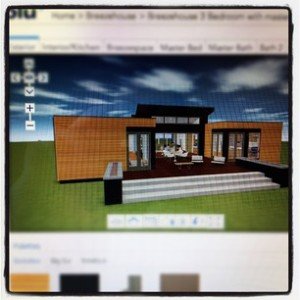Consumers spend a lot of money when buying a home, so how can brands get into their consideration set right from the beginning of a home build or purchase project?
Deciding about tile, paint color, trim, appliances is way more fun than mortgage rates, water heaters, insulation, and septic. Can companies offering these services get closer to the consumer earlier? They can if they partner with home builders.
Blu Homes Unique Values
Blu Homes designs and builds modular homes with a focus on the environment and healthy, sustainable materials. Their home designs are incredibly modern and chic and not the boxy, boring modular homes of the past.
Their focus on modern living, environment, customization, and design make them a perfect partner for many brands who want to take advantage of the money consumers spend in conjunction with their home purchase.
Blu Homes 3-D Configurator is a Great Asset
Blu launched a 3-D application that allows the user to design homes from various model types. The user selects what they want, and as easily as buying a book online, they buy a home and have it delivered to their property.
The configurator gets as granular as offering 4 different types of kitchens featuring different appliances and brands, depending on the level selected. The inclusion of brands like Sub-Zero, KitchenAid, and Whirlpool is a great tool for matching consumer’s needs with the right kitchen design.
For a niche company, this tool is a real differentiator. It also could be their greatest marketing asset.
Kitchens and Baths Sell Homes
Why stop with offering a variety of refrigerators and dishwashers? We know kitchens and baths sell homes, and consumers spend a lot of time considering those rooms, both pre- and post-purchase.
Getting to a consumer during key buying moments is a key to success
What if Whole Foods — wholly committed to core values shared with Blu Homes, from sustainable products to healthy living — could deliver a fully stocked pantry and fridge upon move in to a new Blu home? Add a component to the Blu Configurator for various types of food and a budget, and Blu takes care of the rest. Whole Foods may then choose to promote this to their 2.2 million Twitter followers and expose Blu to a larger audience.
Pottery Barn has an entire organic bath line of products. If the Blu user could select a certain color scheme for their bath, could Blu’s tool also suggest matching towels? With 770,000 Facebook fans, Pottery Barn could give Blu greater reach. While, in turn, Pottery Barn could reach an audience of people using the Blu Configurator who are directly in the market for a new bath.
Capitalize on Consumer Spending Patterns
Weddings and new homes or renovations are peak spending stages in consumers’ lives. Could Blu Homes offer Dwell Magazine, a publication all about “At Home in the Modern World” (in which modular homes are often advertised), to all new homebuyers as a welcome gift? Dwell’s advertisers could then benefit from greater reach to a highly targeted market, and the consumer gets a great resource for their home planning.
They wouldn’t have to stop with kitchens and baths. Think Prius, think Energy Star or CFLs, think cloth diapers, but just think.
Even big retailers like Target are trying to determine how to reach customers before they have babies to capitalize on pre-baby spending and build lifetime value.
Read Charles Duhigg’s New York Times article
Aligning brands together who share values and audience is win-win. Blu has a captive audience of people, certainly smaller than that of Whole Foods or Pottery Barn, who are spending a lot of money at a time in their lives when they have a budget for new home items. Getting to a consumer during key buying moments is a key to success.
Something to Think About
Who in your market attracts your consumer before you do, and how can you insert yourself earlier in buying decisions?
